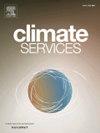IF 4
3区 环境科学与生态学
Q2 ENVIRONMENTAL SCIENCES
引用次数: 0
摘要
为描述区域气候变化,气候服务通常依赖于气候模式模拟集合。区域尺度观测约束条件的发展和到来对这种方法提出了质疑,因为一些模拟结果可能与这些技术估计的变暖轨迹不一致。本研究提出了一种描述未来区域变化的方法,该方法结合了多种信息来源:应用于 CMIP6 集合的全球和区域观测约束条件,以及 CMIP5 驱动的现有区域气候模式模拟。这种方法使用区域变暖水平(RWLs),与 IPCC 第六次评估报告中使用的全球变暖水平(GWLs)如出一辙。我们将其应用于法国本土,该地区在全球模式、区域模式和观测约束之间存在变暖预测差异。结果表明,由于某些模式中区域与全球变暖比率过低,标准全球升温潜能值方法产生了不切实际的低变暖估计值。使用 RWL 可以将年平均升温估算(基于观测约束条件)与详细的气候变化特征(基于区域模式)分离开来。我们探讨了将 RWLs 和 GWLs 联系起来的方法,并评估了相关的不确定性。这种方法被选来描述法国本土未来的气候变化,作为法国政府制定的适应参考轨迹定义的一部分。该方法可在其他地区推广,并可应用于现有或即将发布的气候预测,从而在全国范围内用区域变暖水平来表示。实际意义法国政府最近选择采用法国适应气候变化的参考轨迹,即 TRACC(Trajectoire de Réchauffement de référence pour l'Adaptation au Changement Climatique)。与 1850-1900 年相比,该轨迹确定了国家需要做好准备的 3 个水平,分别对应 2030 年全球升温 +1.5 °C、2050 年升温 +2 °C、2100 年升温 +3 °C。其目的是为气候变化影响研究建立一个单一框架,包括气候服务、适应行动的定义和分析、全国范围内的标准化实践以及促进对气候挑战的一致响应。本文介绍了与这一轨迹相关的方法选择,其基础是描述与所选全球轨迹一致的固定区域升温水平(RWL)的未来变化。就法国本土而言,与 1850-1900 年相比,3 个 TRACC 水平分别为 2030 年全国平均升温 2 ℃、2050 年 2.7 ℃ 和 2100 年 4 ℃。这些数值是根据观测制约因素,结合模式和观测结果得出的。随后对地方尺度气候变化的描述是基于现有的区域气候模型模拟。文章最后描述了与这三个区域变暖水平相关的一些变化。本文章由计算机程序翻译,如有差异,请以英文原文为准。
Using regional warming levels to describe future climate change for services and adaptation: Application to the French reference trajectory for adaptation
To describe regional climate change, climate services typically rely on an ensemble of climate model simulations. The development and arrival of observational constraints at regional scales are questioning this approach, as some simulations may not align with warming trajectories estimated by these techniques. This study proposes a methodology for describing future regional changes that combines multiple sources of information: global and regional observational constraints applied to the CMIP6 ensemble, along with existing regional climate model simulations driven by CMIP5. This approach uses Regional Warming Levels (RWLs), mirroring the use of Global Warming Levels (GWLs) in the IPCC AR6. We apply it to mainland France, a region with discrepancies in warming projections between global models, regional models, and observational constraints. Results show that the standard GWL approach produces unrealistically low warming estimates due to overly low regional-to-global warming ratios in some models. Using RWLs allows separation of the annual mean warming estimation (based on observational constraints) from the detailed climate change characteristics (based on regional models). We explore ways to link RWLs and GWLs and assess associated uncertainties. This methodology has been selected to describe future climate change in mainland France, as part of the definition of a reference trajectory for adaptation set by the French government. It can be replicated in other regions and applied to existing or upcoming climate projections to express them in terms of regional warming levels at the national scale.
Practical implications
The French government has recently chosen to adopt a reference trajectory for adaptation to climate change in France, known as the TRACC (Trajectoire de Réchauffement de référence pour l’Adaptation au Changement Climatique). This trajectory defines 3 levels to which the country needs to prepare for, corresponding to +1.5 °C global warming in 2030, +2 °C in 2050 and +3 °C in 2100 compared to 1850–1900. The aim is to establish a single framework for climate change impact studies including climate services, the definition and analysis of adaptation actions, standardizing practices nationwide and facilitating a coherent response to climate challenges. This article describes the methodological choices associated with this trajectory, based on a description of future changes at a fixed regional warming level (RWL) consistent with the chosen global trajectory. For mainland France, the 3 TRACC levels are expressed as an average warming over the country of 2 °C in 2030, 2.7 °C in 2050 and 4 °C in 2100 compared to 1850–1900. These are derived from observational constraints, combining models and observations. The subsequent description of local scale climate change is based on existing regional climate model simulations. The article finally provides a description of some of the changes associated with these 3 regional warming levels.
求助全文
通过发布文献求助,成功后即可免费获取论文全文。
去求助
来源期刊

Climate Services
Multiple-
CiteScore
5.30
自引率
15.60%
发文量
62
期刊介绍:
The journal Climate Services publishes research with a focus on science-based and user-specific climate information underpinning climate services, ultimately to assist society to adapt to climate change. Climate Services brings science and practice closer together. The journal addresses both researchers in the field of climate service research, and stakeholders and practitioners interested in or already applying climate services. It serves as a means of communication, dialogue and exchange between researchers and stakeholders. Climate services pioneers novel research areas that directly refer to how climate information can be applied in methodologies and tools for adaptation to climate change. It publishes best practice examples, case studies as well as theories, methods and data analysis with a clear connection to climate services. The focus of the published work is often multi-disciplinary, case-specific, tailored to specific sectors and strongly application-oriented. To offer a suitable outlet for such studies, Climate Services journal introduced a new section in the research article type. The research article contains a classical scientific part as well as a section with easily understandable practical implications for policy makers and practitioners. The journal''s focus is on the use and usability of climate information for adaptation purposes underpinning climate services.
 求助内容:
求助内容: 应助结果提醒方式:
应助结果提醒方式:


